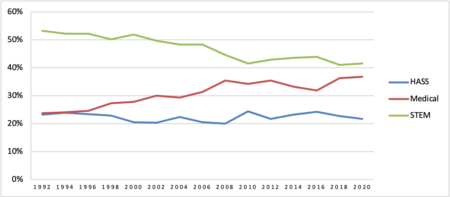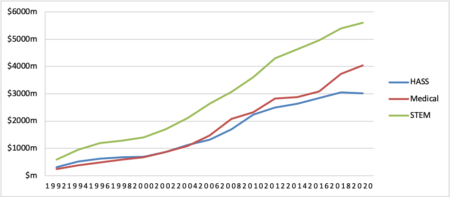July 14, 2023
IRU Response to Discussion Paper: Improving Alignment and Coordination between the MRFF and MREA
The IRU appreciates the opportunity to contribute to the consultation process aimed at optimising the government’s investments in health and medical research through the Medical Research Future Fund (MRFF) and the NHMRC’s Medical Research Endowment Account (MREA). The IRU strongly supports the intention of the consultation, which seeks to improve alignment and coordination between the MRFF and MREA funds, as the first part of an overall national strategy for government investment in health and medical research.
The MRFF and MREA together award around $1.5 billion in medical research grants each year, a critical part of the $4.0 billion spent annually by universities on medical research (in 2020). It is entirely legitimate for government to set priorities to guide this investment. A healthy research and innovation system should include a mix of strategically-oriented “top-down” initiatives, alongside investigator-led “bottom-up” programs that allow new ideas to emerge through peer-review and research excellence. The MRFF priority-driven and MREA investigator-led programs are complementary for this purpose. The Health and Medical Research Office (HMRO) has also made progress to improve the transparency, administration and understanding of the unique purpose of the MRFF.
Each of the Models outlined in the Discussion Paper offer a credible pathway for improved administration efficiency and possible improvements to the governance of the MRFF. The relative effectiveness of each Model will likely depend on how they are designed, implemented and align with the future national strategy for health and medical research. The effectiveness of the MRFF will also depend upon Australia’s broader research and higher education policy framework, much of which is currently under review or yet to be fully implemented (e.g. the Biomedical Translation Fund, National Reconstruction Fund, National Science and Research Priorities, University Research Commercialisation Action Plan and changes from the Australian Universities Accord).
Given the current uncertainties in Australia’s research policy, the IRU’s preference is for Model 2. Model 2, with the NHMRC managing the MRFF but retaining separate funding streams with distinct funding responsibilities, strikes an appropriate balance between administrative consolidation/ streamlining, while retaining distinctive advisory structures for the priority-driven MRFF initiatives and investigator-led MREA programs. Model 2 offers greater certainty for improved operational and administrative efficiency in both the MRFF and the NHMRC, while maintaining flexibility to minimise unintended consequences and retain the unique features and purposes of the MRFF during implementation of the governance reforms. The operational changes could be implemented quickly, while the governance structure under Model 2 could be co-developed with the sector following the development of the national strategy, ensuring it is consistent with the strategy.
The relatively modest objectives of Model 1 (i.e. clearer funding responsibilities to maximise complementarity; joint policies; harmonisation of grant procedures) could likely be addressed without any substantive changes to the governance structure. Essentially the risk of Model 1 is the lost opportunity to more effectively achieve governance reforms that address stakeholder concerns for greater consumer involvement, better support for research translation and commercialisation, and significantly improved strategic coordination.
The more substantial governance changes outlined in Model 3 carries the greatest implementation risks. A single grant program and advisory group would need to be carefully designed. It would need to preserve the unique value of the MRFF and NHMRC, maintaining transparency and certainty in how the funds will be distributed towards the divergent goals of the two funds. Given the scale of change and uncertainties in advance of the national strategy, Model 3 carries the greatest risks.
The IRU is also supportive of other elements of the MRFF outlined in the discussion paper. These include:
- A continued focus on priority-driven and translational research that embeds research in the primary care, hospital and public health systems.
- Representation from consumers, community and industry in priority setting and assessment (where appropriate).
- Funding to target discrete populations (e.g. geographically, linguistically and other marginalized groups) or areas of unmet need.
- Mission based funding providing depth and consistency in funding areas.
- Ability to respond quickly with funding, while also having a commitment to research integrity and peer review in allocation.
- Funding processes that are operationally transparent, effective and efficient, including alignment and coordination for applications, platforms (Sapphire), post-award and reporting.
- A clear distinction between the goals and assessment processes for excellence-based discovery research through expert peer review, and translational research where the role of consumers and community are critical.
- Supporting a diverse, multiskilled, multidisciplinary and sustainable research workforce.
Improved alignment and coordination between the MRFF and MREA funds will benefit all Australians, but an effective MRFF and MREA cannot be achieved in isolation of broader research policy framework. Translational research depends on a strong pipeline of discovery-based research and a research workforce with the opportunity to pursue long term careers and ideas. Universities and the NHMRC play critical roles supporting basic scientists and research communities that are outside of MRFF priorities. Coordination of investment between the MRFF and MREA can strengthen translation and support a diverse, multiskilled and multidisciplinary workforce, but limited term funding for projects and investigators cannot achieve a sustainable research workforce in the absence of regular block grant funding underpinning academic careers. It is important that the MRFF/MREA support the development of basic research and the health research sector. This should be investigated further in the development of the national strategy.
Australian health and medical research has grown considerably over the past three decades. In 2020, Australian universities spent $4.0 billion on medical research (Higher Education Research and Development expenditure, HERD), primarily using their own general university funds to build and extend capacity. Medical research now comprises roughly one third (32%) of total HERD, a record high and up from one fifth in the early 1990s. Medical research has grown at almost double the rate of research expenditure in other fields and is a dominant element of Australia’s research system. But this growth has primarily been driven by metropolitan-based Group of Eight (Go8) universities where 70% of medical research is undertaken and medical research comprises 37% of all HERD. Medical research comprises only 25% of HERD at other universities and around 13% for universities in regional areas. Some research concentration in metropolitan universities for discovery-based research is justified due to the need for scale and excellence, but translational research that embeds research into health practice should aim to benefit Australians equally across all geographical areas. The translational research undertaken at universities away from the major metropolitan centres is often accompanied by direct and tangible benefits accruing to local communities, many of whom are from minority or marginalised groups. Non-metropolitan institutions frequently partner with state and territory agencies to directly improve the lives of everyday Australians where they live. Alleviating some of the geographical inequalities in health research and translation should be investigated as part of the national strategy.
Figure 1. Higher Education Research and Development (HERD) expenditure by field, 1992 to 2020 (% of total)

Figure 2. Higher Education Research and Development (HERD) expenditure by field, 1992 to 2020 ($ millions)

Source: Australian Government (2022), Higher education expenditure on R&D by higher education provider.







